tadamichi
Workers still leveraging this historically tight labor market, but a little more cautiously?
We’re going to look at two different data sets released on Wednesday that show from different perspectives how tight the labor market still is, how much power has shifted from employers to workers, how much job-hopping and churn is still going on, and that the tech layoffs are still not large compared to the gigantic overall labor force, and that most of the laid-off people are getting quickly absorbed by other companies, including by non-tech companies that employ armies of tech workers, such as automakers, industrial companies, oil and gas companies, etc. These companies have gotten outcompeted for tech talent by the lavish compensation packages offered by tech companies. And those non-tech companies are now hoping for better access to the tech labor pool.
The reason for the still huge amount of job-hopping and churn is the promise of the greener grass on the other side of the fence, despite large pay increases for people who stayed.
And the grass is still greener, a sign of aggressive recruiting by employers. The median annual pay of workers who changed jobs increased by 15.1% in November; while for workers who stayed in their jobs, it increased by 7.6%, according to the ADP National Employment Report on Wednesday. But this huge pay increase for job hoppers was down by about 1 percentage point from the 16%-plus range earlier this year – a sign that perhaps a little more caution has entered into the hiring equation.
Annual Pay Increase: Job Changers Vs. Job Stayers (Median % Change) (Author)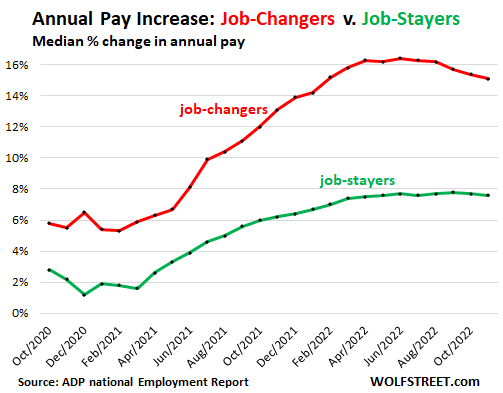
Fed Chair Jerome Powell in his speech on Wednesday dedicated considerable time describing the issues of the still far too tight labor market – including the still huge number of job openings and just how little cooling was actually visible.
He was referring to the Job Openings and Labor Turnover Survey (JOLTS), released by the Bureau of Labor Statistics on Wednesday, based on what 21,000 businesses said about the number of job openings they have, the number of people they actually hired, the number of people they laid off, the number of people who quit, etc.
Job openings fell by 353,000 in October, undoing some but not all of the gains in the prior month. At 10.33 million, job openings in October were still higher than in August, and were still up by 3 million, or by 41%, from October 2019.
While they remain in the astronomical zone, they have come down by about 1.5 million from the peak in March 2022 – and this includes a portion in the tech sector where the layoffs have been, as we’ll see in a moment.
Job Openings, Total (In Thousands, Seasonally Adjusted) (Author)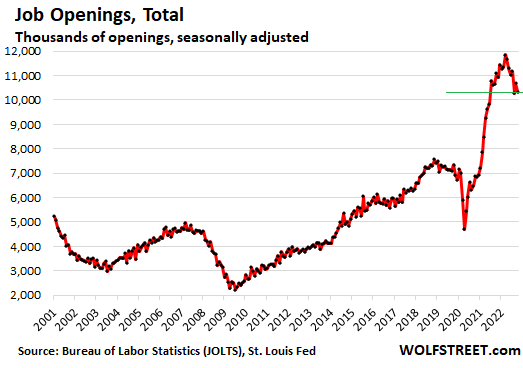
Layoffs & discharges rose by 58,000 in October, after having fallen more than that in September, and were still lower than in August. Employers reported that they laid off and discharged for whatever reasons 1.39 million employees, and while that sounds like a lot, it is historically low in the huge workforce in the US, and down by 23% from October 2019, which had already been a tight labor market:
Total Layoffs & Discharges (In Thousands) (Author)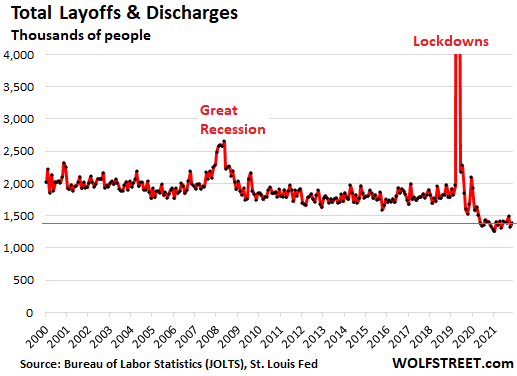
Laid-off workers were quickly rehired
Most people that were laid off found new jobs quickly in this sea of job openings, and we see this everywhere, including in the actual number of people who filed for unemployment insurance with their state unemployment offices.
The number of initial claims for unemployment insurance, at 240,000 last Thursday, was up from prior weeks but was still below where it had been in August and July, and was in the same low range where it has been all year, and historically low.
In other words, most of the people who were laid off found a job so quickly or already had a new job lined up that they didn’t file for unemployment compensation.
When looking back at the past decades, we can see that the number of initial unemployment claims would have to rise well above the 300,000 mark before the labor market begins to soften meaningfully:
Initial Employment Claims (Seasonally Adjusted) (Author)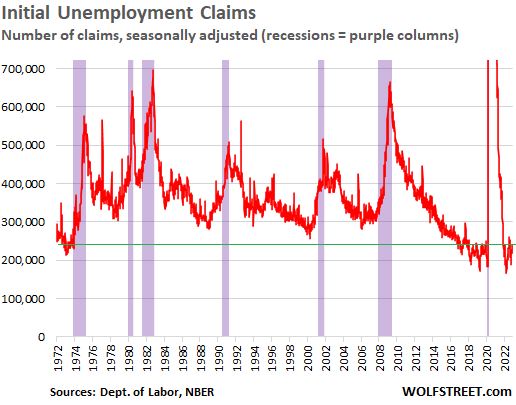
Voluntary “quits” dipped for the second month in a row, to 4.03 million, the lowest since May 2021 – a sign that employees are getting a little more cautious about riding the job-hopping train, and perhaps a sign that some job openings to hop into have vanished.
But the number of quits is still historically high, up by 18% from three years ago, and still far higher than at any time before 2021, a sign that workers are still arbitraging the labor market in large numbers to increase their pay – and they did increase their pay, as the ADP data above for job changers shows:
Quits, Total (In Thousands) (Author)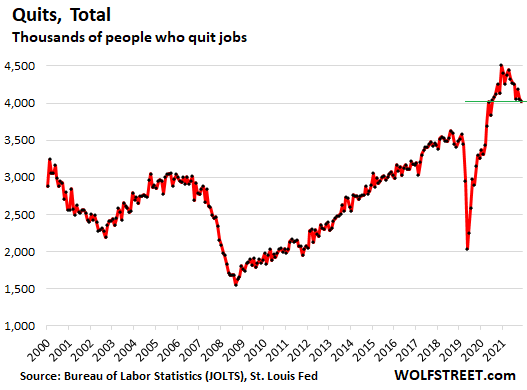
The number of new hires fell for the second month in a row, to 6.01 million people in October – but still up by 4% from three years ago, and higher than any month before the pandemic. Hiring is still handicapped by the tight labor market, the difficulties in actually being able to hire people away from other employers.
Most of the 1.39 million people who were laid off and most of the 4.03 million people who voluntarily “quit” became part of the 6.01 million people who were hired by other employers.
Hires, Total (In Thousands, Seasonally Adjusted) (Author)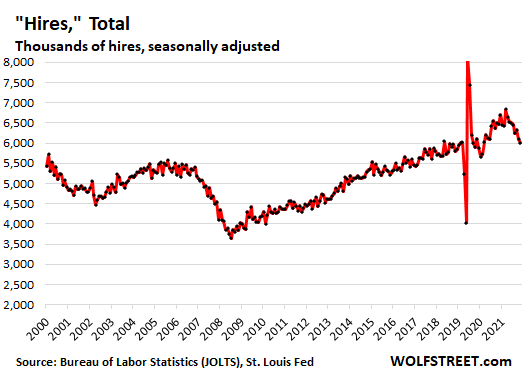
Job openings in major industry categories
Professional and business services, a big category with 22.4 million employees in Professional, Scientific, and Technical Services; Management of Companies and Enterprises; Administrative and Support, and Waste Management and Remediation Services.
This is where part of the tech jobs are, and where part of the tech layoffs have occurred.
- Job openings: -146,000 to 1.79 million, the lowest since May 2021, but still very high
- From 3 years ago: +49%
Professional & Business Services Job Openings (In Thousands, Seasonally Adjusted) (Author)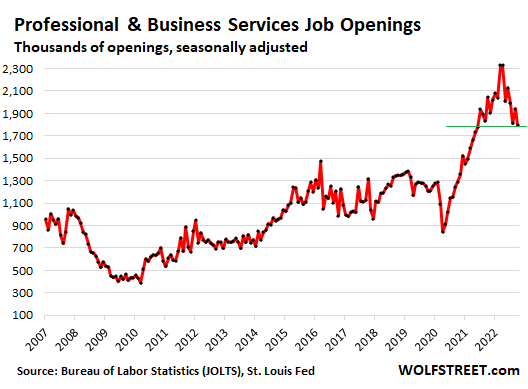
Information, a small category with 3 million employees in web search portals, data processing, data transmission, information services, software publishing, motion picture and sound recording, broadcasting including over the Internet, and telecommunications.
This is also where some of the tech layoffs have been. But job openings have risen over the past two months!
- Job openings: +5,000 to 235,000, very high, still screaming labor shortage!
- From three years ago: +57%
Information Job Openings (In Thousands, Not Seasonally Adjusted) (Author)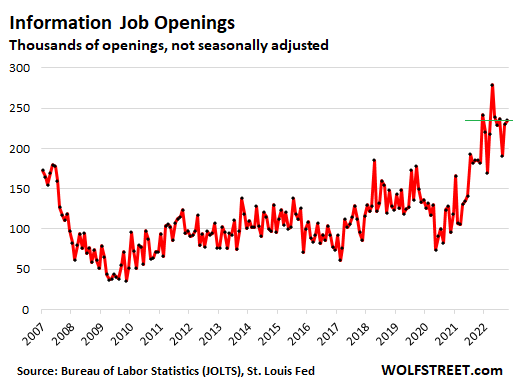
Healthcare and social assistance, a large category with about 21 million employees: job openings dipped from the record in September, amid continued staffing shortages:
- Job openings: -86,000 from record in the prior month, to 2.0 million
- From three years ago: +69%
Healthcare & Social Assistance Job Openings (In Thousands, Seasonally Adjusted) (Author)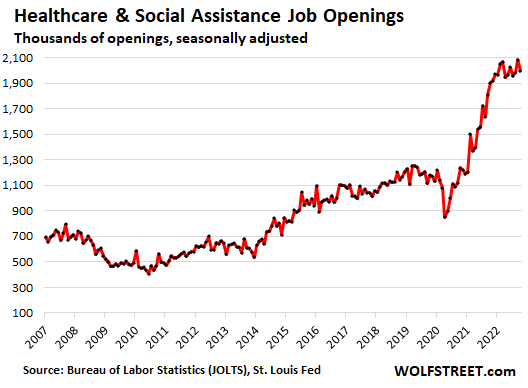
Leisure and hospitality, with about 16 million employees, with restaurants and hotels still struggling with staff shortages:
- Job openings: unchanged at 1.58 million
- From three years ago: +59%
Leisure & Hospitality Job Openings (In Thousands, Seasonally Adjusted) (Author)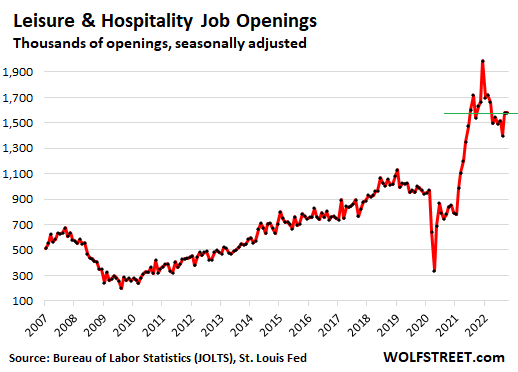
Retail trade, with about 16 million employees, has now normalized in terms of job openings. This is the only sector where job openings are now roughly back where they were before the pandemic.
- Job openings: +24,000 to 879,000
- From three years ago: -1%.
Retail Trade Job Openings (In Thousands, Seasonally Adjusted) (Author)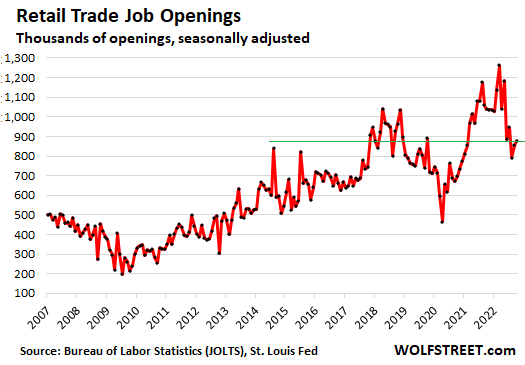
Education – as indicated by state & local government job openings, most of which are in education. The teacher shortage seems to be abating a little:
- Job openings: -78,000, third month in a row of declines, to 802,000 openings, the lowest since March 2021
- From three years ago: +22%
Mostly Education: State & Govt. Job Openings (In Thousands, Seasonally Adjusted) (Author)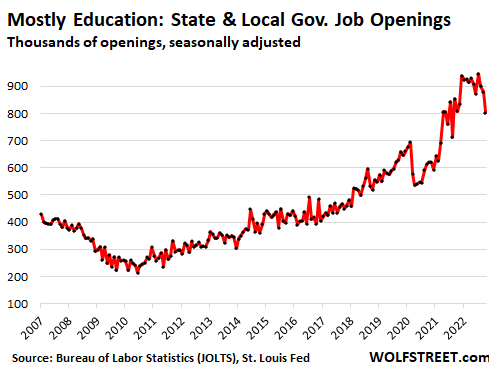
Manufacturing, with about 13 million employees:
- Job openings: -89,000, the third month in a row of declines, to 746,000, the lowest since December 2021, but still very high and speaking of a labor shortage
- From three years ago: +87%!!!
Manufacturing Job Openings (In Thousands, Seasonally Adjusted) (Author)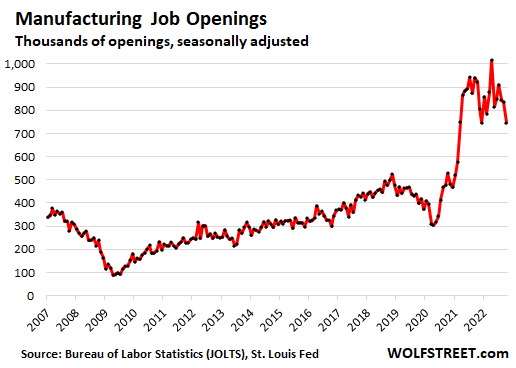
Construction, with about 8 million employees, in all types of construction:
- Job openings: +52,000 to 371,000
- From three years ago: +15%
Construction Job Openings (In Thousands, Seasonally Adjusted) (Author)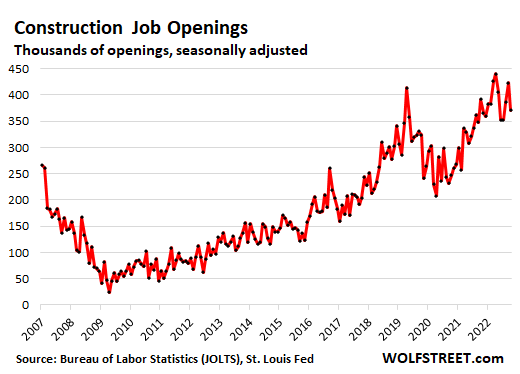
Editor’s Note: The summary bullets for this article were chosen by Seeking Alpha editors.


Be the first to comment